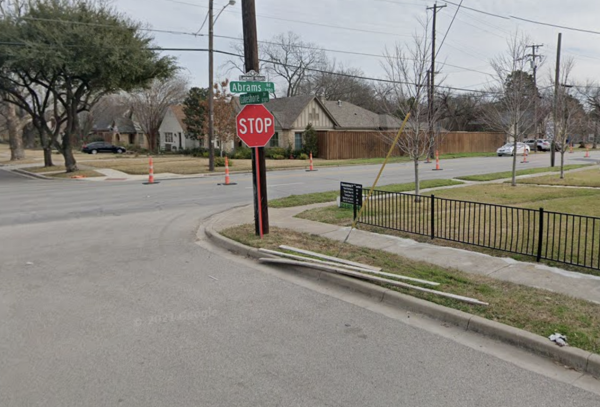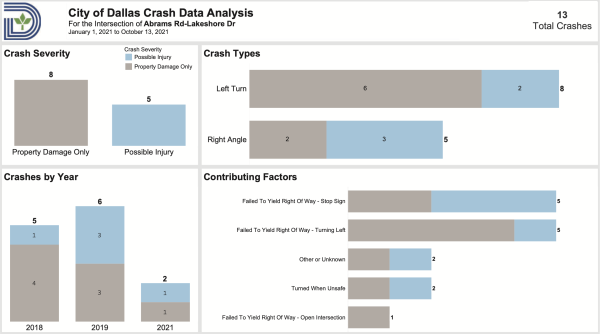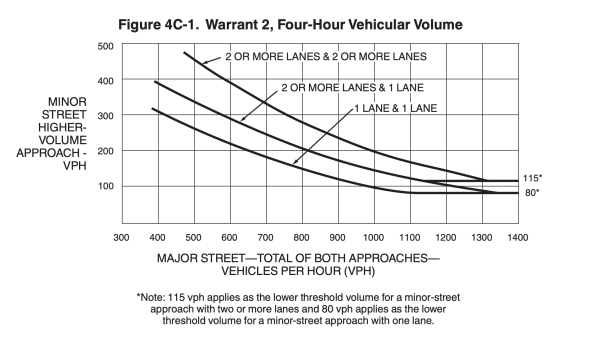
Photo courtesy of Google Maps.
Neighbors who live near the Lakeshore Drive and Abrams Road intersection have seen that most of the accidents that occur there are caused when drivers make left turns.
So when Gus Khankarli, the City of Dallas’ director for the Department of Transportation, and other officials told them that left-turn signals weren’t included in the current design, neighbors didn’t understand.
In Monday’s community meeting hosted by District 9 Dallas City Council member Paula Blackmon, neighbors questioned why including left-turn arrows wasn’t a priority, why a signal would be installed before a study could examine traffic throughout the entire Abrams Road corridor and how adding another light would solve the problem.
“I just feel that we must do something, but it doesn’t mean that it’s going to stay there forever when we have the whole corridor,” Blackmon said.

Crash data from the City of Dallas.
This whole process started in 2016 when a citizen requested the City look into adding a traffic signal at the intersection. The City, which has to constantly evaluate roadways to make sure they’re safe, began a warrant study to determine whether a signal should be placed at Abrams-Lakeshore.
In the 2011 Texas Manual on Uniform Traffic Control Devices, there are nine warrants, or criteria, to look for in the kind of study the City was doing in 2016. Not all nine warrants must be met for a signal to be installed, but “the satisfaction of a traffic signal warrant or warrants shall not in itself require the installation of a traffic control signal,” according to the manual.
When the City completed the study, staff found that warrant 2, four-hour vehicular volume, was met. It says:
“The need for a traffic control signal shall be considered if an engineering study finds that, for each of any 4 hours of an average day, the plotted points representing the vehicles per hour on the major street (total of both approaches) and the corresponding vehicles per hour on the higher-volume minor-street approach (one direction only) all fall above the applicable curve in Figure 4C-1 for the existing combination of approach lanes. On the minor street, the higher volume shall not be required to be on the same approach during each of these 4 hours.”

Figure 4C-1, Warrant 2, Four-Hour Vehicular Volume. 2011 Texas Manual on Uniform Traffic Control Devices.
The signal was included in the 2017 bond program and was approved. After that, the design process began.
Now, the design process is complete. However, City officials said they don’t expect the signal to actually be installed for at least a year because of supply chain issues, among other reasons.
When neighbors kept bringing up the lack of a left-turn arrow in current designs, City officials said with the latest technology, adding a left-turn arrow would be an easy modification. Once the Abrams corridor study is complete, and once the signals along Abrams (including the ones at Abrams and Richmond) are replaced with new versions, the City will be able to sync up the signals to work together and control the flow of traffic.
One neighbor asked City staff at the meeting if they had actually seen the intersection in person and wondered how adding another light on a stretch of road that already has several lights would solve the problem.
To stop the traffic signal from being installed, another study would have to be done to prove that a signal would no longer meet any of the warrants. But at this point, City officials expect a new study would still show a signal is warranted based on crash experience, warrant 7.
Residents at the meeting said speeding is an issue on Abrams, and many people use Lakeshore as a cut-through. City officials advised them to talk with their Council member or put in a service request through 311 to add stop signs along the neighborhood road.
There’s still much to be discussed. Blackmon and District 14 Council member Paul Ridley will be inviting interested neighbors to join small groups to talk about what has already been designed and what a left-turn arrow would add. Currently, the design also calls for pedestrian crosswalks and signals with ADA ramps at all corners of the intersection.
The groups will come back together at the end of January 2022 for another community meeting.





